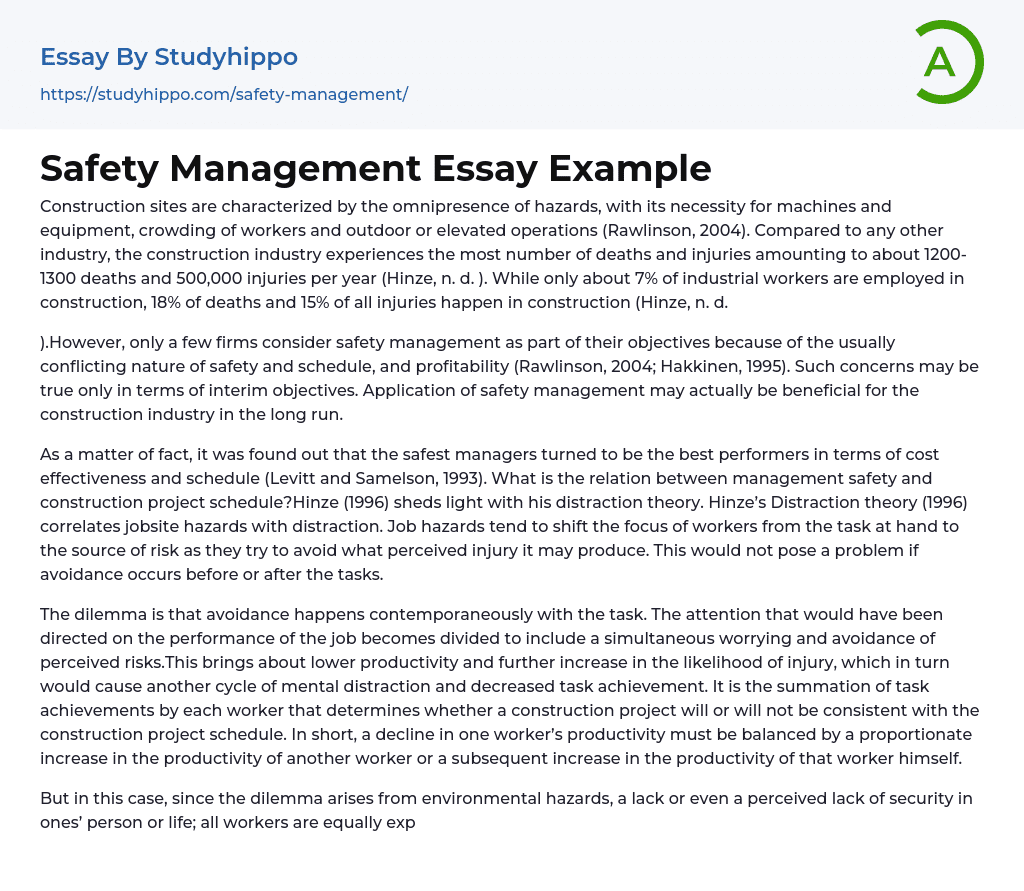According to Rawlinson (2004), construction sites are notorious for their hazardous conditions, which arise from the use of machinery and equipment, a large number of workers, and activities carried out outdoors or at great heights. In fact, the construction industry has the highest fatality and injury rates compared to other sectors. Hinze (n.d.) estimates that approximately 1200-1300 deaths and 500,000 injuries occur in this industry each year.
Despite employing only approximately 7% of industrial workers, the construction sector is responsible for 18% of fatalities and 15% of all injuries (Hinze, n. d.). Regrettably, safety management often takes a backseat in many firms due to conflicts with timeframes and profitability (Rawlinson, 2004; Hakkinen, 1995). Nevertheless, implementing safety management can ultimately prove advantageous for the construction industry.
According to Levitt and Samelson (1993), the study found that managers w
...ho were the most secure were also the most efficient performers in terms of cost effectiveness and scheduling. Hinze (1996) explores the relationship between safety management and construction project schedules through his distraction theory. According to Hinze's (1996) distraction theory, on-site hazards are connected to distraction. Hazards in the workplace cause workers to shift their attention from the job at hand to the potential source of danger, in an effort to prevent potential injuries. This becomes problematic when avoidance occurs simultaneously with tasks, as it interrupts workflow.
The division of job performance into two aspects, which are worrying about perceived risks and avoiding them, leads to decreased productivity and increased chances of injury. This results in a decrease in overall worker productivity due to the cycle of mental distraction and decreased task achievement. In construction projects, the success relies on the collectiv
efforts of all workers. Therefore, if one worker's productivity decreases, it must be compensated by another worker's increase or an improvement in their own productivity. However, all workers are equally susceptible to distractions caused by environmental hazards and lack of security. Consequently, the likelihood of individual workers balancing each other out to meet the construction project schedule decreases.
It is crucial to note that even if the reduction in productivity only affects one stage of the project, any delay puts the entire schedule at risk. Unless these circumstances are anticipated, included, and accounted for when creating the schedule (Rowlinson, 2004), any delay can jeopardize the entire schedule. Hence, implementing measures to eliminate factors causing mental distraction—such as ensuring worker safety—can minimize the discrepancy between planned and actual work schedules.
The second most serious impact of accidents on construction sites is the interruption of work schedule (Rowlinson, 2004). To minimize this problem, it is important to reduce the frequency of accidents in the construction business, which can lead to decreased manpower due to absenteeism and high turnover rate. This will also reduce the chances of rework and schedule extensions, as increased focus on tasks by workers will lead to better quality monitoring and less worry about accident risks. It is a misconception that management safety conflicts with profitability; instead, implementing management safety measures in construction enhances workers' sense of security. By preventing distractions and divided attention, workers are able to concentrate on their tasks, resulting in increased productivity and improved consistency with the construction project schedule.
The implementation of safety procedures in management is vital for determining the competitiveness of a construction business and its construction project timeline. The
quality, safety, and reliability of the work schedule are significant indicators of the company's strength and competitiveness. It is crucial to prioritize safety over profitability as it not only endangers workers' lives but also goes against the company's dedication to profitability.
Works Cited
Hakkinen K. (1995). A learning-by-doing strategy to improve top management involvement in safety.
- Building essays
- Automotive essays
- Automotive Industry essays
- Commerce essays
- Construction essays
- E Commerce essays
- Grocery stores essays
- Paper Industry essays
- Pharmaceutical industry essays
- Pharmacy essays
- Polymers essays
- Real Estate essays
- Textile Industry essays
- Board Of Directors essays
- Brand Management essays
- Business Ethics essays
- Business Management essays
- Change Management essays
- Comparative Analysis essays
- Decision Making essays
- Dispute Resolution essays
- Knowledge Management essays
- Leadership essays
- Leadership and Management essays
- Manager essays
- Operations Management essays
- Performance Management essays
- Product Management essays
- Project Management essays
- Quality Management essays
- Risk essays
- Risk Management essays
- Scientific Management essays
- Stress Management essays
- supply chain management essays
- Time Management essays
- Total Quality Management essays
- Code of Ethics essays
- Conflict essays
- Dress Code essays
- Human Resources essays
- Organizational Behavior essays
- Performance essays
- Recruitment essays
- Safety essays




